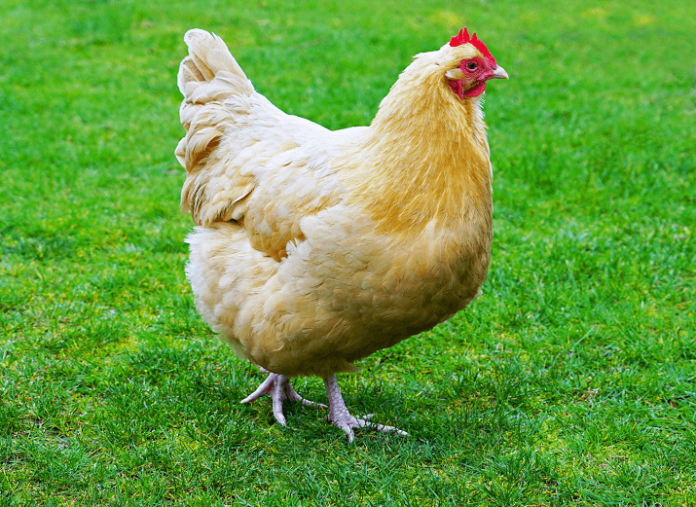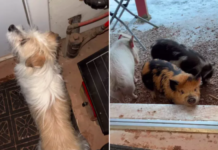Last Updated on July 2, 2021 by Fumipets
There is no other breed of Chicken that is quintessentially English like the Buff Orpington.
People nearly often imagine a fat, majestic, richly feathered hen going about her business in the barnyard as if she owned it and was in no rush!
The Orpington, as we’ll see, is a relatively new breed developed by a man who believed it was feasible to make a dual-purpose bird that was larger and better than current varieties.
This article focuses on the ever-popular Buff Orpington and explores its temperament, breed features, egg-laying skills, and recognised varieties.

Overview
| Buff Orpington Chicken | |
|---|---|
| Beginner Friendly: | Yes (very docile and suited to urban life). |
| Lifespan: | 8 years. |
| Weight: | Hens (6-8lb) Roosters (8-10lb). |
| Color: | Buff. |
| Egg Production: | 3-5 per week. |
| Egg Color: | Light brown. |
| Known For Broodiness: | They do have a tendency towards broodiness. |
| Good With Children: | Gentle breed that is ideal for kids. |
| Cost of Chicken: | $3-4 per chick. |
History
The Buff Orpington has a long and illustrious history.
In the late 1880s, England was experiencing a resurgence of ‘chicken fever.’
People had shifted their focus away from the novelty of breeding and raising a variety of exotic and strange birds for the sake of curiosity and amusement, and toward developing a more practical and useful bird.
William Cook, a coachman from Orpington in the county of Kent, England, was one of these people.
He didn’t become interested in chickens until later in life, but he was enthralled by the prospect of producing a superior bird for both the table and the production of eggs.
He started by looking for birds that were excellent layers and a decent table size. Minorca, Langshan, and Plymouth Rocks were the three breeds he adopted at first.
In 1886, he ‘unveiled’ the Black Orpington breed, which, thanks to widespread publicity, became an almost instant success in England.
It was developed to be black in order to conceal the grime and soot that plagued towns at the time.
The Buff was the second colour to be shown, and it is still the popular hue of Orpington chickens. The White and Blue, as well as the Splash colours of the bird, were also following behind.
Mr. Cook garnered acclaim in the United Kingdom when he unveiled his birds to the general public. It quickly became the most popular breed in the country, and it was exported to other nations, notably the United States, within 10 years.
In South Africa, there was even an Orpington ranch! When Cook travelled to the United States to market his bird lines, he had a lot of success.
He was apparently a natural marketer, as he soon piqued the attention of farmers and poultry enthusiasts in his dual-purpose breed.

The Creation of the Buff Orpington
At the beginning of this article, you’ll recall that the Langshan, barred Rock, and Minorca were used to construct the original black Orpington.
Because none of those breeds are remotely ‘buff,’ Mr. Cook created the Buff Orpington by combining gold-streaked Hamburgs, Dorkings, and buff Cochins.
It’s also been suggested that an ancient breed called as the Lincolnshire buff was utilised, though Cook has denied this.
Using many distinct breeds to generate various colour birds of the same name was exceedingly contentious, and it is still uncommon today!
It makes more sense to think of the Orpington as a brand rather than a breed.
The buff was produced to meet a need for buff-colored chickens at the time. It’s a heritage chicken that’s become a popular choice among many people.
They were Queen Elizabeth, The Queen Mother’s favourite breed, and her flock received several honours for their beauty and elegance.
Breed Standard and Appearance
The Orpington breed was considered endangered until 2016.
The breed has officially been removed off the American Breed Livestock Conservancy’s list, thanks to the efforts of numerous home chicken owners.
The number of Orpingtons – notably buffs – has progressively increased due to renewed interest in this favourite.
A large, wide body with a low posture, fluffed out feathers, and a curved, short back should be the look of the bird.
The bird should have wide, smooth feathers and be well-feathered. The skin should be white, and the feet and shanks should be clean and pinkish-white in hue.
The beak is pinkish white as well. Eyes should be a reddish bay hue, with red wattles, comb, and earlobes.
A single comb should have five points; a rose comb is also available.
Large fowl and bantam orpingtons are the two sizes of orpingtons.
The male large fowl should weigh approximately 10 pounds, while the female should weigh approximately eight pounds. Bantams are 38 ounces in weight. 34 oz. and male She is a woman.
In every other way, the bantam should resemble a huge chicken.
If you can locate one, the bantam Orpington is one of the biggest bantams available.
The Buff coloured Orpington was accepted into the American Poultry Association’s standard in 1902, while the black and white colours were accepted in 1905, the blue colour was eventually accepted in 1923
The UK standard specifies that the body should be deep and wide, curved, and have a shortish tail. The plumage should be ‘close’ rather than ‘fluffy’, as in a Cochin, or ‘tight’, as in a Game Fowl.

Disposition and Egg Laying
The buff Orpingtons are known to be the most docile and friendly of the Orpingtons.
They are calm and elegant, almost gliding over the barnyard until they are chasing goodies, in which case they raise up their ‘skirts’ and sprint like wild!
They like being hugged and will often seek you out to signal that they want your attention.
Their magnificent feathering makes them incredibly cold and resilient, however they may swiftly freeze and perish if their feathers get wet. Orpingtons can live in hotter areas, but they require access to shade throughout the day.
They form excellent broods and moms. They frequently allow the placement of hatching eggs under them.
The buff roosters are highly protective of their young and will even sit on the nest for a while to give mom a respite!
They are a popular option among many families since the buff is excellent with children, tolerant of any kind of misbehaviour.
Keep an eye on them, however, since they have a powerful beak that can administer a devastating peck if necessary.
Since they take handling and confinement so well, they make a fantastic project bird for 4H clubs because they are so relaxed and friendly.
These same characteristics make them excellent exhibition birds since they are unaffected by frequent handling, unexpected locations, or odd sounds.
They are tolerant to confinement and, though they may roam freely, they seldom forage, depending instead on the feeders.
They lay roughly 200–280 big brown eggs each year and are dependable layers. They’re ready to eat at roughly 22 weeks if you’re growing them as a meat bird.
They’re commonly referred to as the “ideal” dual-purpose chicken.

Is Buff Orpington the Right Breed for You?
This may be the chicken for you if you want a large fluffy bird that lays well, has a nice demeanour, and tolerates little children.
They have a family-oriented flock because to their calm, gentle, and sociable attitude. They have good social skills and I don’t think they have a nasty bone in their body.
You should not mix them with more aggressive breeds like Rhode Island Reds or Welsummers because of their non-aggressive disposition.
They’ll most likely be picked on and pushed to the bottom of the food chain.
If you live in a city or town, the buff is a peaceful bird that is well-suited to being kept in a smaller yard. They are an excellent bird for novices since they are simple to care for and need little upkeep.
The only flaw in their beauty is their tendency towards broodiness. The buff, on the other hand, is ideal for raising your own chicks! They are excellent mothers who provide excellent care for the chicks.
Because these enormous birds cannot survive high temperatures, you should give shade, ventilation, and plenty of room for them. With their extremely fluffy feathers, they are able to shrug off the cold in the winter.
Because of their thick feathers, they should be examined for lice and mites on a regular basis and treated appropriately. Because it’s difficult to notice small creepy crawlies amidst all those feathers, many people treat them with poultry dust on a regular basis.
Because they are such huge birds, they are prone to idleness and should be given as much activity as possible.
Feeding
Orpingtons Take Pleasure in Eating. They may be heavy feeders with a proclivity towards obesity, which must be regulated for the health of the bird.
Although the Buff Orpington loves its time at the feeder, it is not a slacker forager. The Orpington will do a good job of finding what she needs in the barnyard as a middle-of-the-road free-range bird.
With that said, she enjoys receiving gifts, and if you’re sitting on the porch or having a picnic, she’ll show up and demand her own plate.
Because of its great size and low feather density, the Orpington is a tough bird for predators to kill. This affectionate breed is also wary of predators, which may explain why it prefers to stay around around the feeders.
Your hens will have an additional set of eyes looking out for them if you add a rooster to your free-range flock.
Coop Setup
For all chickens, the typical standard is 4 square feet of coop area per bird.
While this is appropriate for Orpingtons, if you have the opportunity to offer them a little more room, do do – after all, they are huge fluffy females! They don’t mind crowding together in the winter, but they like a little more personal space in the summer.
Each chicken will need a minimum of 8 inches of perch space.
Just keep in mind that perches should be no more than 18-24 inches from the ground to minimise leg damage.
Standard-sized nesting boxes (12 x 12 inches) are available. Too much space encourages them to share nesting boxes, resulting in hen squabbles and damaged eggs.
For every 2-3 Buff Orpingtons, one box should be provided.
Everyone will have a favourite nesting box, but having a large number of boxes accessible can help keep the whining to a minimal.

Conclusion
The Buff Orpington breed revolutionised the dual-purpose chicken industry. Until they arrived, the average table hen was often thin and not the finest egg layer.
The buff is the most popular colour out of all the options.
This might be due to the warm hue of the feathers paired with a relaxed and welcoming demeanour. They aren’t as loud as some other kinds, and they aren’t as forceful.
The Orpington has survived despite controversies and family feuds.
Backyard chicken lovers were instrumental in halting and reversing declining numbers.
The breed (particularly the buff) is seeing a rebirth in popularity, demonstrating that heritage birds have a place in everyone’s heart and home.


















